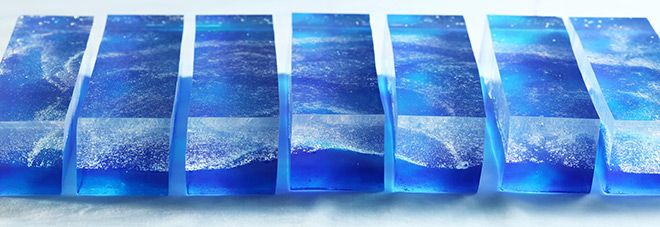“Neo wagashi,” a modern twist on traditional Japanese sweets, is gaining popularity with its photogenic appearance that is perfectly suited for today’s social media era.
Long-established shops and even a convenience store now offer neo wagashi that break from traditional methods, ingredients and shapes to attract new customers.
EVOLUTION OUT OF NECESSITY
“Merely preserving the tradition was no longer sustainable for our livelihoods,” said Shintaro Sato, the eighth-generation owner of a 202-year-old confectionery shop.
A popular product from his Noshiume-honpo Satoya shop in Yamagata is “kingyokukan” (a jelly-like confection) named “Sora no Muko,” which resembles a night sky full of stars.
The shop’s unique kingyokukan, made by boiling agar with sugar and then cooling it, features irregular curves of blue and purple layers. Bubbles of various sizes float inside.
When tasted, it offers a subtle hint of a ginger.
“I wanted people to enjoy the ingredients used in wagashi,” Sato said.
He launched the sweet in 2019, inspired by glasswork.
The following year, it was introduced on X, formerly Twitter, with a description of being “breathtakingly beautiful.” The tweet received more than 330,000 likes.
Sato’s creative idea stemmed from worries about the future of his store.
After graduating from a university in Tottori, Sato trained for five years at a long-established confectionery in Kyoto before returning to Yamagata in 2007.
Satoya’s signature sweet is “Noshi Ume,” a candy made from ripe plums.
Customers would say, “That brings back memories,” but not many said they had recently eaten one.
Sales, which had been strong during the bubble economy from the 1980s to the early 1990s due to corporate demand, were on a downward spiral.
Sato told veteran confectioners, “Let’s make something that has tenfold the value, though it takes ten times longer to make.”
They began incorporating new ingredients, such as ganache and rum, into their sweets and continuously created new products.
This year, the shop collaborated with a local Belgian beer specialty store to introduce a beer-infused “yokan” (sweet jellied red bean paste).
“I would like to expand the neo wagashi movement through collaborations with companies from different industries,” Sato said.
APPEALING TO YOUNGER GENERATIONS
In November, the shop Takeno to Ohagi, with two locations in Tokyo’s Setagaya and Meguro wards, showcased a circular bento box containing seven varieties of “ohagi” (sticky rice balls coated with sweet red bean paste), each capturing the essence of autumn.

In addition to the standard “koshi-an” (pureed sweet red-bean paste) and “tsubu-an” (mushed sweet red-bean paste), there are daily special ohagi inspired by seasons, the weather and new encounters.
With its visually appealing ohagi, the shop has 178,000 Instagram followers so far, drawing fans nationwide.
Hiroki Ogawa, who previously ran a delicatessen, started the shop in 2016.
“I want to pass on my grandmother’s ohagi recipe,” he said.
He learned how to make ohagi on his own while continuing to create new versions of it.
“I want to value daily changes and the seasons just like a chef examines fish and vegetables at the market when planning a menu,” he said.
Meanwhile, leading convenience store chain Lawson Inc. began selling a bright blue “ramune mochi” (soda rice cake) six years ago with the aim of “making wagashi more accessible to younger generations.”
Sales have been strong, leading to an expanding lineup year after year.
This year, the convenience store has already released 18 types of neo wagashi.
Sweets journalist Rio Hiraiwa said the term “neo wagashi” started appearing more frequently in the media about 10 years ago.
“Wagashi was long dominated by established, traditional shops,” she said. “But since anyone can share their creations through social media, attention has also turned to unique confectioners.”
The beauty of traditional sweets, such as “kohakuto” (candy crystals) created during the Edo Period (1603-1867), are also regaining the spotlight.
“I hope while preserving traditional Japanese ingredients and methods, the confectionery industry will continue to develop with the original purpose of confections: bringing joy to people,” Hiraiwa said.

